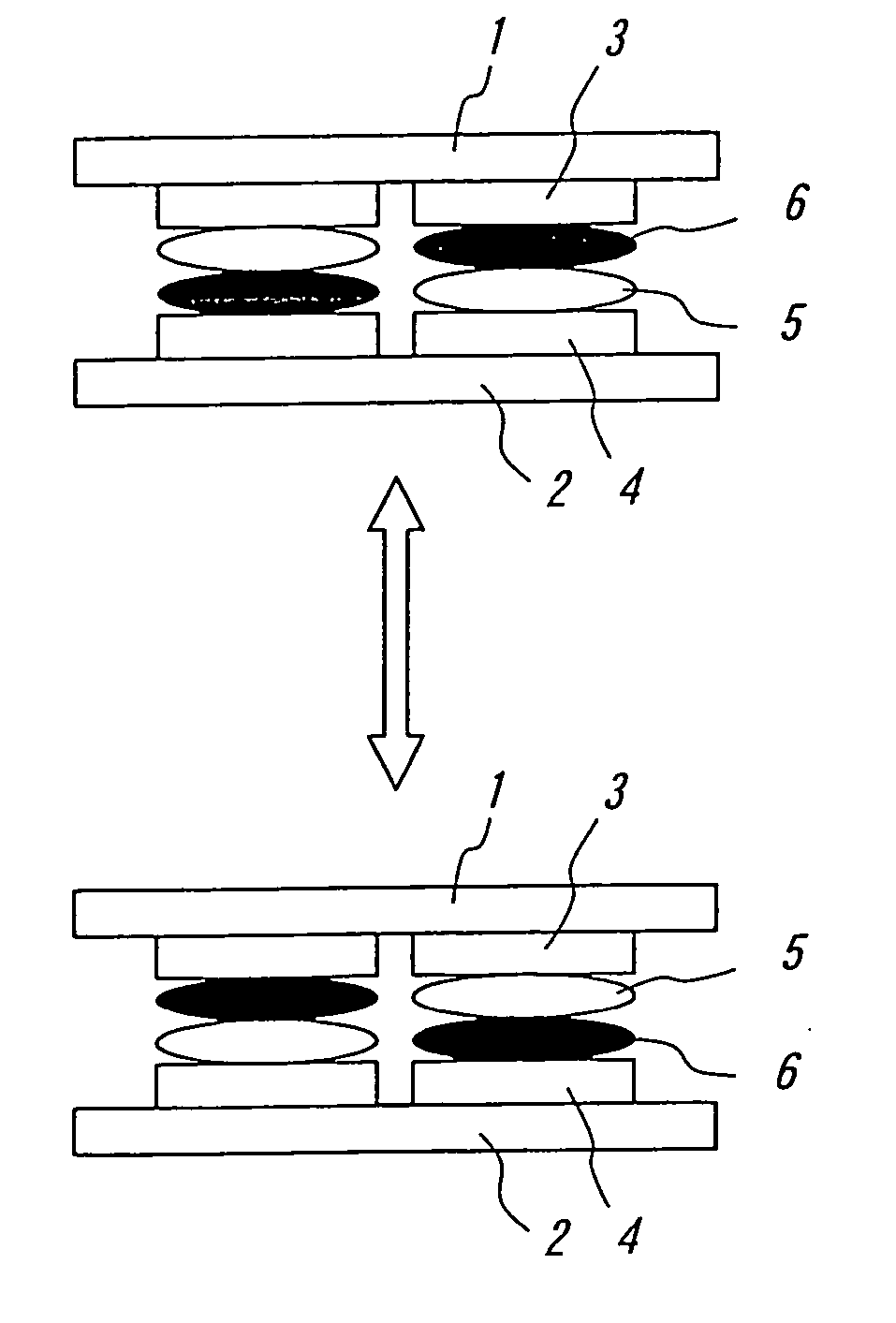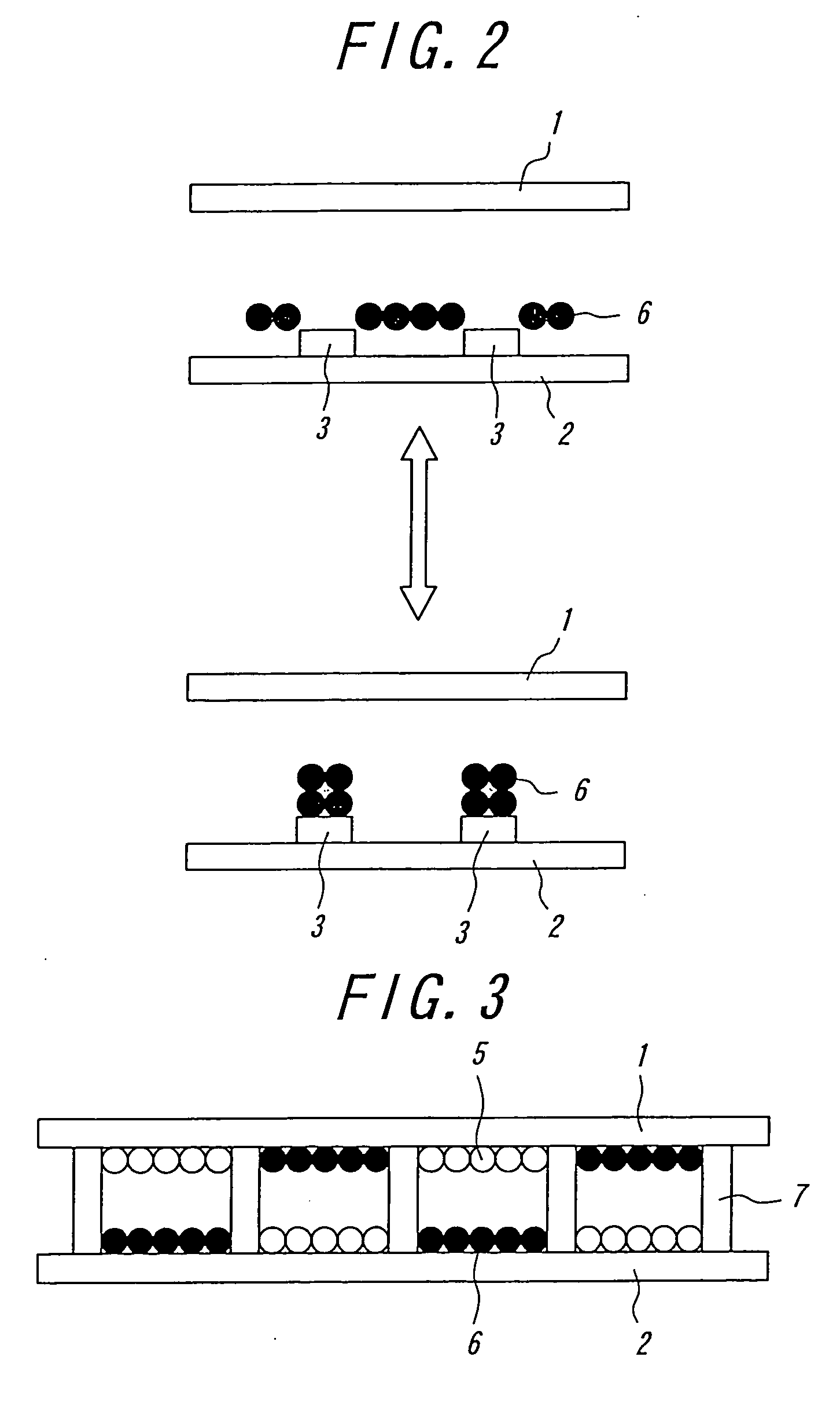Image display and method for manufacturing image display
- Summary
- Abstract
- Description
- Claims
- Application Information
AI Technical Summary
Benefits of technology
Problems solved by technology
Method used
Image
Examples
example 1
First Embodiment: Particles
[0232] A polymer, in which hydroxy group of saturated polyester was substituted into metacryoxy group, was used as a base resin. By utilizing the base resin, a solution, in which 15 wt % of toluene was included, was prepared. With respect to 100 parts by weight of the base resin, 2 parts by weight of benzoil peroxide, 5 parts by weight of butylated melamine resin (produced by DAINIPPON INK AND CHEMICAL, INCORPORATED, Super Bekkamin L125-60), 3 parts by weight of phosphoric methacrylate (produced by Kyoei Kagaku Kogyo Co., Ltd., PIM), 20 parts by weight of polyethylene glycol diacrylate, 0.5 parts by weight of γ-methacryoxypropyltrimethoxysilane, were added and then mixed to obtain a mixture. Then, 4 parts by weight of conductive particles (produced by Nippon Chemical Industrial CO., LTD., 16GNR10.0MX, particle diameter: 5 μm) with respect to 100 parts by weight of the base resin was mixed with the mixture, and cast at 70° C. by means of a roll coater, so ...
example 2
First Embodiment: Particles
[0237] An image display device was prepared in the same manner as that of the example 1 except that use was made of 20 parts by weight of neopentyl glycol dimethacrylate in spite of 20 parts by weight of polyethylene glycol diacrylate during the anisotropic film forming in the example 1.
[0238] An adhesion force of the anisotropic conductive film was 1.1 kg / inch, and a conductive resistance thereof was 2.5 Ω. The performance of the image display device was the same as that of the example 1.
REFERENCE EXAMPLE 1
First Embodiment: Particles)
[0239] An image display device was prepared in the same manner as that of the example 1 except that butylated melamine resin and phosphoric methacrylate were not used during the anisotropic film forming in the example 1.
[0240] An adhesion force of the anisotropic conductive film was 0.4 kg / inch, and a conductive resistance thereof was 2.9 Ω. The performance of the image display device was the same as that of the example...
example 3
Second Embodiment: Liquid Powder
(Production of Anisotropic Conductive Film)
[0251] A polymer, in which hydroxy group of saturated polyester was substituted into metacryoxy group, was used as a base resin. By utilizing the base resin, a solution, in which 15 wt % of toluene was included, was prepared. With respect to 100 parts by weight of the base resin, 2 parts by weight of benzoil propylether (photosensitizer), 5 parts by weight of butylated melamine resin (produced by DAINIPPON INK AND CHEMICAL, INCORPORATED, Super Bekkamin L125-60), 3 parts by weight of phosphoric methacrylate (produced by Kyoei Kagaku Kogyo Co., Ltd., PIM), 20 parts by weight of polyethylene glycol diacrylate, 0.5 parts by weight of γ-methacryoxypropyltrimethoxysilane, were added and then mixed to obtain a mixture. Then, 4 parts by weight of conductive particles (produced by Nippon Chemical Industrial CO., LTD., 16GNR10.0MX, particle diameter: 5 μm) with respect to 100 parts by weight of the base resin was mi...
PUM
| Property | Measurement | Unit |
|---|---|---|
| Fraction | aaaaa | aaaaa |
| Time | aaaaa | aaaaa |
| Time | aaaaa | aaaaa |
Abstract
Description
Claims
Application Information
 Login to View More
Login to View More - R&D
- Intellectual Property
- Life Sciences
- Materials
- Tech Scout
- Unparalleled Data Quality
- Higher Quality Content
- 60% Fewer Hallucinations
Browse by: Latest US Patents, China's latest patents, Technical Efficacy Thesaurus, Application Domain, Technology Topic, Popular Technical Reports.
© 2025 PatSnap. All rights reserved.Legal|Privacy policy|Modern Slavery Act Transparency Statement|Sitemap|About US| Contact US: help@patsnap.com



